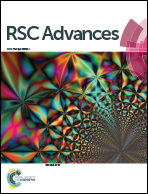Pre-drawing induced evolution of phase, microstructure and property in para-aramid fibres containing benzimidazole moiety†
Abstract
Copoly(p-phenylene-benzimidazole-terephthalamide) (PBIA) fibre was spun by wet-spinning and drawn in a coagulating bath with different pre-drawing ratios (R). The evolution of phase, microstructure structure and conformation induced by pre-drawing were studied by 2D-wide angle X-ray diffraction (2D-WAXD), attenuated total reflection-Fourier transform infrared (ATR-FTIR) and scanning electron microscope (SEM). WAXD results indicate that mesomorphic/amorphous coexisting phases transform to crystal/mesomorphic/amorphous coexisting phases when R is higher than 75%. Even when R reaches an ultimate value of 100%, the content of crystalline is only 10.7% but the mesomorphic phase content is higher than 40%, which indicates that the 3D well defined crystalline structure is disturbed by the introduction of asymmetric benzimidazole units. The ATR-FTIR results indicate that the increase of R leads to conformational order, contributing to phase transition. The results of SEM show that PBIA fibres have a typical skin–core morphology. The sizes of micro-fibrils in the core part become more homogeneous with the increase of R. Moreover, with the increasing R from 0% to 100%, the tensile strength and initial modulus of the PBIA fibre significantly increase from 7.8 cN dt−1 to 21.5 cN dt−1 and from 238 cN dt−1 to 884 cN dt−1, respectively. Dynamic mechanical analysis (DMA) of PBIA fibres shows two transition peaks, and some amorphous phase is confined by the order phases.


 Please wait while we load your content...
Please wait while we load your content...